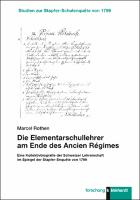Die Elementarschullehrer am Ende des Ancien Régimes
Eine Kollektivbiografie der Schweizer Lehrerschaft im Spiegel der Stapfer-Enquête von 1799
Author(s)
Rothen, Marcel
Collection
Swiss National Science Foundation (SNF)Language
GermanAbstract
"The distorted stereotype of the pre-modern elementary school teacher as a poor starving man with deficient educational knowledge is still omnipresent in historical depictions of the Swiss elementary school system. Nevertheless, little is known about the social profile and the lives of elementary school teachers around 1800. From the Elementary School Survey of 1799, known as the Stapfer-Enquête, biographical data of over 2,300 teachers is available, which was analyzed quantitatively and comparatively using the methodological approach of collective biographies in order to explore the social profile, biographical careers and social status of elementary school teachers in the Helvetic Republic. With regard to the social background of teachers at the beginning of the 19th century, the study shows that, contrary to the perceived poverty paradigm, the majority of teachers – female teachers were still the exception – were not recruited from the lowest social strata, but came from small-scale farms and craft milieus of the local middle classes. In addition, regional surveys show that there was no lack of suitable candidates for the school classrooms, and that the teaching profession even represented an attractive communal resource. Furthermore, despite the enormous local disparities, not every teacher was destitute, for many teachers were able to support their families from teaching income alone, as teachers, on average, had more children than those of similar occupational groups. The fact that the teaching profession was not an opportunistic alternative occupation becomes apparent in a comparison of the generationally differentiated career paths. Regardless of their financial situation, the majority of elementary school teachers took up the teaching profession as adolescents or young adults and pursued it in the long term. Upon assumption of the teaching profession, many teachers also changed their professional profile in the sense of a destratification of their gainful activities. Discontinuous professional profiles became more frequent, in that former activities were consciously renounced or replaced by church auxiliary service. The beginning of the professionalization of the teaching profession can thus already be dated in the career paths of teachers before 1800, despite the still missing uniform training structures. The teaching profession itself, along with the frequently practiced connection with church auxiliary
service, gave teachers a high intangible social capital in addition to income. This social capital is reflected in above-average marriage rates for teachers. Furthermore, regional sources reveal a high degree of satisfaction with the teachers‘ professional performance, often in harsh contrast to critical individual reports, which simultaneously attest to professional incompetence. In this way, these often-criticized elementary school teachers were the central diffusers of Swiss literacy, which was already largely comprehensive around 1800, putting their performance and the early modern educational system in a brand new light. "
Keywords
Stapfer-Schulenquête, Elementarbereich, Elementarpädagogik, Bildungsgeschichte, Ancien Régime, Lehrer, Schulgeschichte, Biografie, Berufsbiografie, Sozialer Status, Soziale Herkunft, Sozioökonomischer Status, Lehrerbild, Geschichte <Histor>, Helvetik, Professionalisierung, Sozialkapital, Historische Quelle, Lehrberuf, Stapfer, Philipp Albert, 18. Jahrhundert, Aufklärung <Epoche>, Frühe Neuzeit, Quellenanalyse, Biografische Methode, Umfrage, Dissertationsschrift, SchweizDOI
10.35468/5891ISBN
9783781524491, 9783781558915Publisher
Verlag Julius KlinkhardtPublication date and place
Bad Heilbrunn, 2021Series
Studien zur Stapfer-Schulenquête von 1799,Classification
History of education


 Download
Download Web Shop
Web Shop